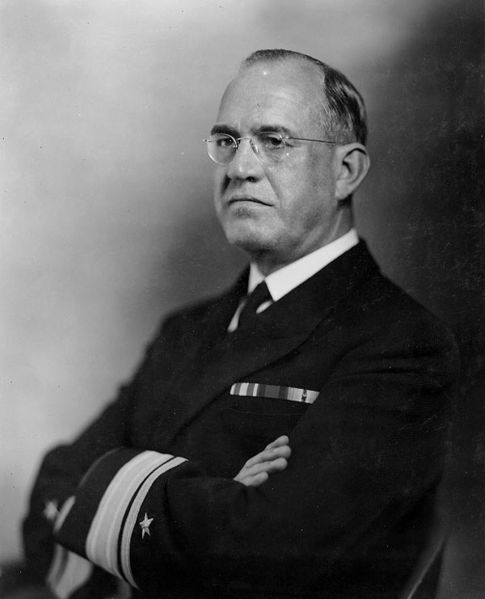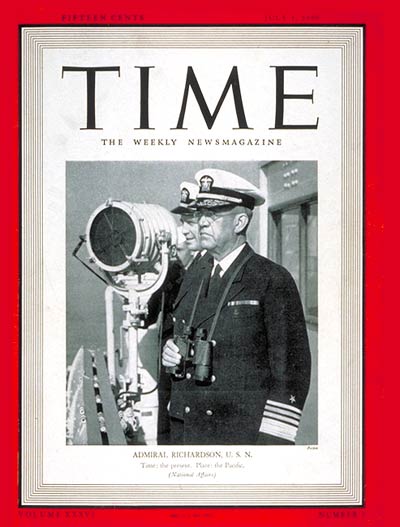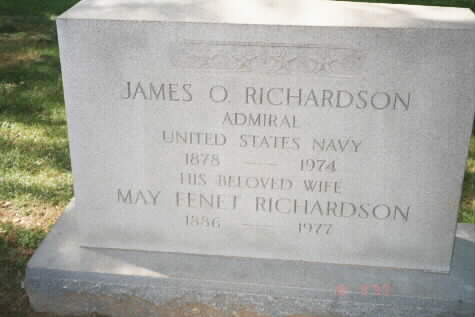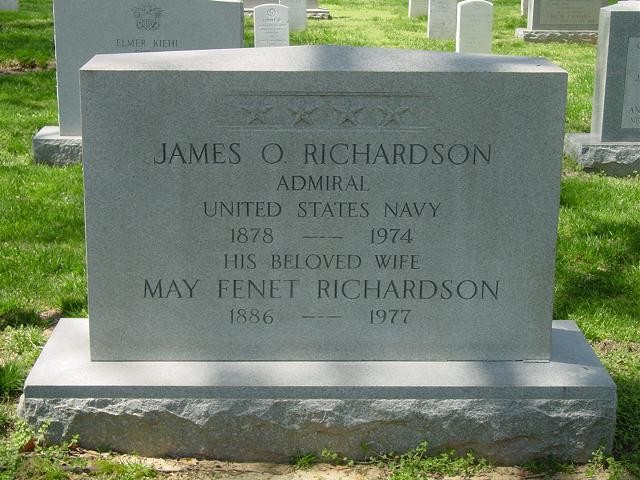Admiral James O. Richardson, USN, (1878-1974)
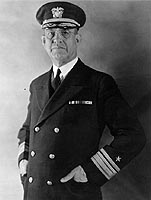
James Otto Richardson was born in Paris, Texas, on 18 September 1878. He entered the U.S. Naval Academy in 1898 and graduated with the Class of 1902. His first duty assignments were on the Asiatic Station and, after 1905, in the Atlantic. During 1907-09, Lieutenant Richardson commanded the torpedo boats Tingey and Stockton and the Third Division, Atlantic Torpedo Flotilla. He was a member of the first class of the Navy’s Post Graduate Engineering School in 1909-11, then served as an engineer in the battleship Delaware and on the staff of the Atlantic Reserve Fleet. In 1914, Richardson was promoted to the rank of Lieutenant Commander and was attached to the Bureau of Steam Engineering at the Navy Department, where he worked to assure the Navy’s supply of fuel oil.
In 1917-19, Commander Richardson was Navigator and Executive Officer of the battleship Nevada. Following a tour at the Naval Academy, he was given command of the gunboat Asheville in 1922 and took her out to Asiatic waters, where he also
had command of the South China Patrol. Captain Richardson was Assistant to the Chief, Bureau of Ordnance, in 1924-27. In the later 1920s, he commanded a destroyer division, then returned to the Navy Department for service with the Bureau of Navigation.
In January 1931, Captain Richardson placed the new heavy cruiser Augusta in commission and commanded her for more than two years. After a tour as a Naval War College student in 1933-34, he was Budget Officer at the Navy Department, receiving promotion to Rear Admiral while in that position in December 1934. His early duties as a flag officer included command of a Scouting Force cruiser division, service as Chief of Staff and Aide to the U.S. Fleet’s commander, and a tour as Commander Destroyers, Scouting Force. He became Assistant to the Chief of Naval operations in June 1937 and a year later became Chief of the Bureau of Navigation.
In June 1939, Richardson went back to sea as Commander, Battle Force, U.S. Fleet, with the temporary rank of Admiral. Beginning in January 1940, he was Commander in Chief, U.S. Fleet, holding that position during a stressful period marked by the fleet’s forward deployment to Pearl Harbor. Relieved by Admiral Husband E. Kimmel in February 1941, he served at the Navy Department into 1942. Transferred to the Retired List with the rank of Admiral in October 1942, he remained on active service with the Navy Relief Society, as Senior Member of a “Special Joint Chiefs of Staff Committee” on the reorganization of the National Defense, and as a witness before the International Military Tribunal for the Far East. Released from active duty in January 1947, he thereafter resided in Washington, D.C.
Admiral James O. Richardson died on 2 May 1974, and was buried with full military honors in Arlington National Cemetery. His wife, May Fenet Richardson (1886-1977) is buried with him.
James Richardson (1878-1974)
James Otto Richardson (18 September 1878 – 2 May 1974 was an admiral in the United States Navy who served from 1902 to 1942.
Early life and career
Richardson was born in Paris, Texas. He entered the Naval Academy in 1898 and graduated fifth in a class of eighty-five with the Class of 1902. His first duty assignments were in the Asiatic Squadron, took part in the Philippine campaign, and, after 1905, in the Atlantic. During 1907-09, Lieutenant Richardson commanded the torpedo boats Tingey and Stockton and the Third Division, Atlantic Torpedo Flotilla. He was a member of the first class of the Navy’s Post Graduate Engineering School in 1909-11, then served as an engineer in the battleship Delaware and on the staff of the Atlantic Reserve Fleet. In 1914, Richardson was promoted to the rank of Lieutenant Commander and was attached to the Bureau of Steam Engineering at the Navy Department, where he worked to assure the Navy’s supply of fuel oil.
World War I and interwar years
In 1917-19, Commander Richardson was Navigator and Executive Officer of the battleship Nevada. Following a tour at the Naval Academy, he was given command of the gunboat Asheville in 1922 and took her out to Asiatic waters, where he also had command of the South China Patrol. Captain Richardson was Assistant to the Chief, Bureau of Ordnance, in 1924-27. In the later 1920s, he commanded a destroyer division, then returned to the Navy Department for service with the Bureau of Navigation.
In January 1931, Captain Richardson placed the new heavy cruiser Augusta in commission and commanded her for more than two years. After a tour as a Naval War College student in 1933-34, he was Budget Officer at the Navy Department, receiving promotion to Rear Admiral while in that position in December 1934. His early duties as a flag officer included command of a Scouting Force cruiser division, service as Chief of Staff and Aide to the United States Fleet’s commander, and a tour as Commander Destroyers, Scouting Force. He became Assistant to the Chief of Naval Operations in June 1937 and a year later became Chief of the Bureau of Navigation.
In June 1939, Richardson went back to sea as Commander, Battle Force, U.S. Fleet, with the temporary rank of Admiral. Beginning in January 1940, he was Commander in Chief, U.S. Pacific Fleet, holding that position during a stressful period marked by the fleet’s forward deployment to Pearl Harbor. Relieved by Admiral Husband E. Kimmel in February 1941, he served at the Navy Department until 1942.
World War II and afterward
Transferred to the Retired List with the rank of Admiral in October 1942, he remained on active service with the Navy Relief Society, as Senior Member of a “Special Joint Chiefs of Staff Committee” on the reorganization of the National Defense, and as a witness before the International Military Tribunal for the Far East. Released from active duty in January 1947, he thereafter resided in Washington, D.C.
Admiral James O. Richardson died on 2 May 1974.
Michael Robert Patterson was born in Arlington and is the son of a former officer of the US Army. So it was no wonder that sooner or later his interests drew him to American history and especially to American military history. Many of his articles can be found on renowned portals like the New York Times, Washingtonpost or Wikipedia.
Reviewed by: Michael Howard

